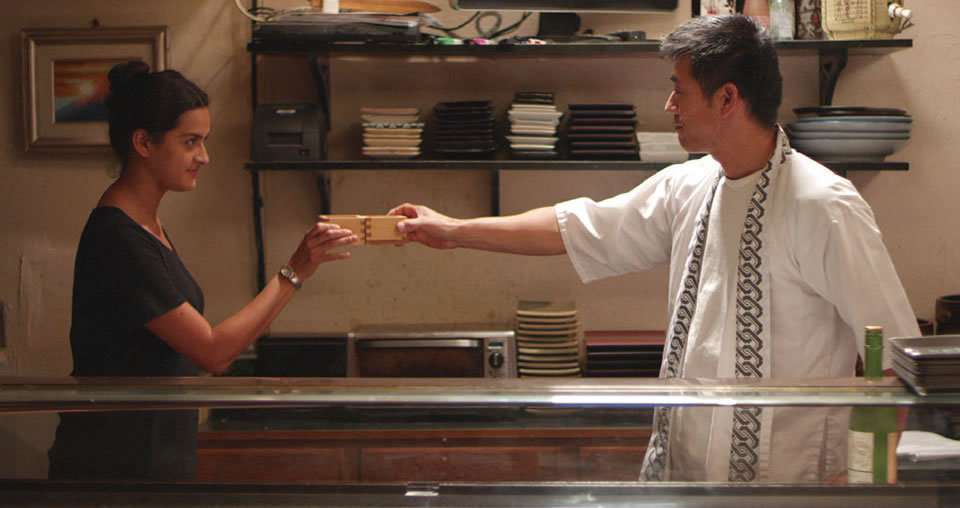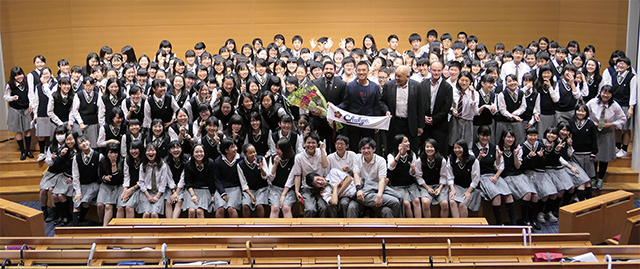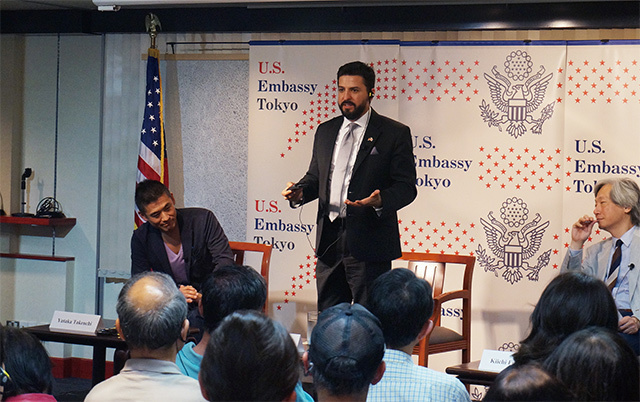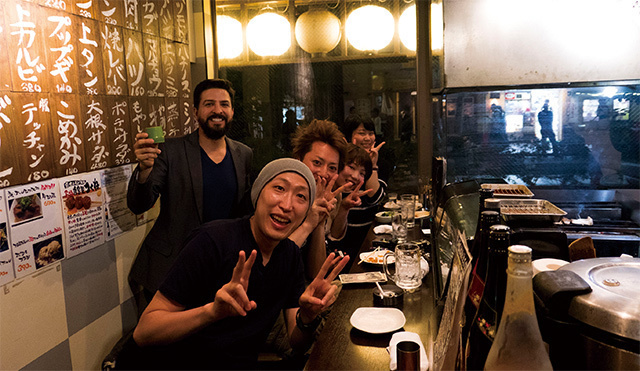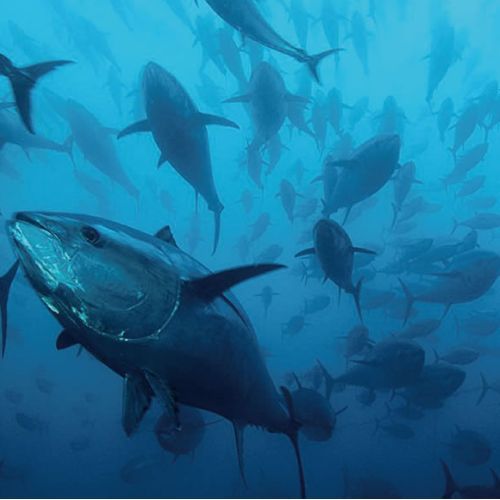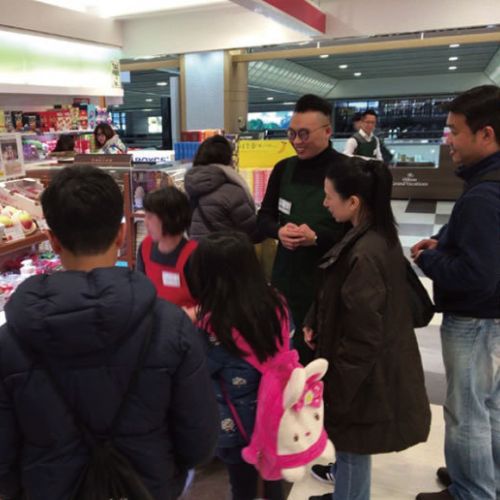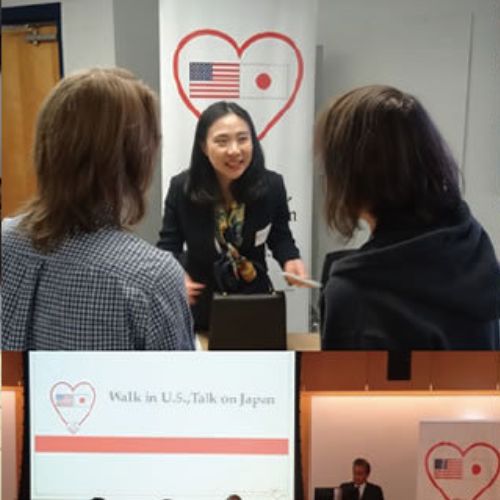“I never thought my film would bring me 14 awards and a trip to Japan,” laughs Anthony Lucero, the director of the film East Side Sushi, a film about a Mexican-American single mother who encounters cultural and traditional barriers as she strives to realize her dream of becoming a sushi chef. In 2017, Lucero traveled along the Japanese archipelago from north (Sapporo) to south (Okinawa City) upon the invitation of the U.S. Embassy and Consulates in Japan, talking about his film to Japanese audiences.
Looking back on his Japan tour, Lucero says he found inspiration everywhere he went. After sampling a wide range of local specialties and meeting people from all walks of life to discover still more captivating aspects of Japan, he now claims, “Had I known all this before I filmed the movie, I might have revised my script!”
After discussing East Side Sushi with Chukyo University Senior High School students in Nagoya, at an event co-hosted with the U.S. Embassy.
Giving a talk at the American Center Japan in Tokyo after screening East Side Sushi, hosted by the U.S. Embassy.
Lucero reveals that during his tour around Japan, some members of his audience remarked it was peculiar for the heroine of his film to wear a watch while making sushi. In fact, the watch had been a necessary technical addition to enable a professional chef to be used as a “hand double” during close-ups of the sushi preparation. “When I went around to local sushi restaurants in Japan, I learned that no sushi master would ever wear a watch during either the preparation or the serving of sushi. I asked the reason, and the answer was ‘In order to present your cuisine to the gods, you must be as pure as possible.’ Here, ‘the gods’ refers to the customers. In Japan, everything seems to be permeated by a certain degree of spiritualism.”
Lucero was intrigued to find how seriously the Japanese regard their meals, whether preparing, serving, or eating them. “The first thing to know about food in Japan is that it is very difficult to find a bad meal anywhere. Japanese people are very committed to their work and to customer service, and they take pride in what they do. Whatever task they do, they aim for perfection. In addition, Japanese customers are very discerning when it comes to their food. That is why Tokyo has the most Michelin-starred restaurants in the world.”
Lucero continued, “What I found most fascinating about Japan is that even average consumers pay considerable attention to where their food originates from, whether it be meat, fish, vegetables, rice, or anything else. If it’s fish, they want to know where in Japan it was sourced from. If it’s beef, they again want to know the region, because they know the differences between beef from Kobe, Matsusaka, and Sendai. They also put tremendous emphasis on eating seasonal ingredients. In the U.S., consumers generally don’t pay that much attention to where the food originates from, and when they order a meal, I rarely see people discussing which fish or vegetables are at the peak of the season. In the U.S. people are more concerned about whether or not something is organic. I was intrigued to see how Japanese select their food in the same way Americans select wine based on the year, region, and type of grape.”
Bumping into locals at a yakitori restaurant in Kyoto. The secret ingredient was the bincho-tan charcoal.
One of Lucero’s favorite foods in Japan was yakitori, chicken dipped in or brushed with sauce and then hand-grilled over charcoal. He couldn’t put his finger on the secret to its remarkable flavor until he realized that many restaurants in Japan use a specific kind of charcoal, called bincho-tan charcoal, to give the yakitori a distinctive, more complex taste. “In the U.S., it is difficult to find restaurants that hand-grill their food over charcoal. But in Japan many restaurants post signs saying that they use this special charcoal, and again consumers are very aware of how that affects the taste.”
Lucero also noticed that the Japanese approach to food was very similar to how he had made East Side Sushi. “Western food is about adding spices and seasonings in the right combinations to make a delicious dish, just like how many of the movies I had worked on previously incorporated lots of visual effects. But Japanese food tries to bring out the ingredients’ natural flavor with a minimum of spices, like using no visual effects in a movie and instead relying on the strength of the story and the acting to pull the viewer along. I could feel the chefs’ pursuit of pureness in Japanese cuisine and I feel I too was trying to capture a pureness in my film,” Lucero explained.
One thing that left a deep impression on Lucero is that some Japanese people who watched his movie commented he had a Japanese soul. “At first I wasn’t quite sure what they meant, but after traveling around Japan, I came to appreciate the spirit of Japanese craftsmanship much more fully. Japanese craftsmen—including those pursuing the craft of sushi making—put their soul into their work to the point that their work becomes art. I put my soul into my film, and I am glad that my passion transcends across borders and people.”
Lucero now lives in Los Angeles and is searching for an opportunity to use these and other areas of inspiration in his life to create his next film.


























